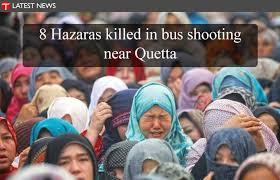
(Credit: twitter.com)
Pakistan has its share of Voldemorts – the dark lords who cannot be named – but none as powerful as this lot: the banned sectarian outfits and their leaders. They kill with impunity, and then move on with their business without the fear of ever being caught, or convicted.
They are brazen and flagrant, they cannot be stopped. And, egregiously, they cannot be named, at least not without risking one’s life.
Owen Bennett Jones, in his book Pakistan: Eye of the storm, narrates a bloodcurdling tale of a Bollywood style drama that unfolded in Lahore during the days Riaz Basra, founder of Lashkar-e-Jhangvi, was still alive.
Contrary to popular belief that PML-N is sympathetic towards their cause, the Nawaz-led government was cracking down hard against sectarian outfits. The bounty on Basra’s head had been increased to make him the most wanted terrorist in the country, and the police were employing all energies to apprehend him.
Miffed at this, Basra decided to send a strong message.
He crept into one of the public meetings held by the Prime Minister, placed himself right behind Nawaz, allowing an accomplice to take pictures in the process; and then three days later sent the print of the same to the PM house, with his and Nawaz’s head encircled, and an inscription underneath reading,
It’s that easy.
It indeed is easy for them to wriggle into the most secure places. Easier still to go ahead and shoot anyone.
No surprises should then come when the common folks, such as the Hazaras, are murdered in dozens with the government failing to provide protection.
Take a look: Situationer: Hazaras: Fault in their faces
Convenience, as expediency in so many other matters, demands that we do not even identify this as a sectarian bloodshed. We shut our eyes, look elsewhere, ignore the elephant in the room and hope peace would somehow prevail.
Where we do indeed identify the killings as being sectarian in nature, we refuse to attribute direct blame; to name names and identify perpetrators. No political party has the guts to directly confront these outfits or to censure them for being completely out of sync with the religion they preach.
Why make enemies of such barbarians?
Hardened by this attitude, the outfits rage on with their sprees.
What had started off as the targeting of hitmen of organisations affiliating with other sects – back in the times when, as Jalib would put it, Zulmat (Darkness) insisted on being called Zia (Light) – slowly moved on to becoming a campaign against the notables. Doctors, lawyers, intellectuals and government servants were the targets in this phase.
Not satiated with the bloodshed and the rewards they had accumulated for the hereafter, these organisations took it a step further.
Thus began indiscriminate sectarian killings.
Pakistanis are killing Pakistanis; Muslims are murdering Muslims. Ubaidullah Aleem had written some 40 years ago:
Main yeh kis ke naam likhoon, Jo alam guzar rahay hain
Meray shehar jal rahay hain, Meray log mar rahay hain
(Whom should I blame for these afflictions; my cities are burning, my people are dying).
Koi aur to nahin hai pas-e-khanjar aazmai
Ham hi qatl ho rahay hain, Ham hi qatl ker rahay hain
(It is not an outsider behind the swashing dagger; we are the ones getting killed and we are the ones doing the killing).
The weapon of choice employed by these outfits to put their point across is violence. The fact that the government has been unable to keep its monopoly on the legitimate use of violence – as a punishment to prevent perpetuation of crime – renders it a failure.
The government too, however, despite the criticism heaped upon it, fails not because of lack of intent but because of failure of mechanism.
There were 40 plus cases registered against Malik Ishaq (the second of the three founders of Lashkar-e-Jhangvi), and of these, he has already been acquitted in about 30. The reason: the witnesses either did not turn up due to fear, went missing, or were killed.
No judge would punish a person if evidence is lacking, even if the perpetrator had owned up to killing at least a hundred Shias in an interview with an Urdu Newspaper in 1997.
Together with a lack of evidence is the predicament of having to contain the sympathy these criminals win with security agencies. The problem of reverse-indoctrination, where prisons instead of acting as the reformation centres end up becoming recruitment fields, further complicates the matter.
Until these issues are addressed head on, and the government is better empowered to deal with them, we are left with only two pitiable solutions:
Solution one: every time a tragedy of the sorts where Hazaras are sprayed with bullets occurs, we shake our heads, condemn the actions of ‘namaloom afraad‘ (unknown people/assailants), gain some mileage by politicising the matter and within days move on, waiting for another such incident to occur in the future.
Solution two: where lack of evidence would merit acquittal of the accused – the extrajudicial killing of criminals in police ‘encounters’.
As a lawyer committed to human rights, I am against both. The former for its passivity, the latter for fear of an innocent person being murdered.
We are trapped.

